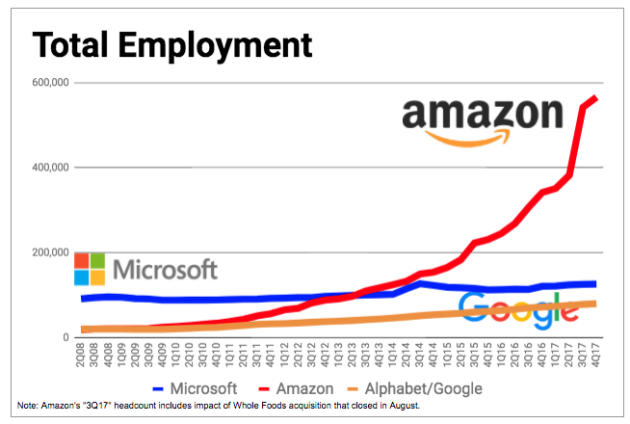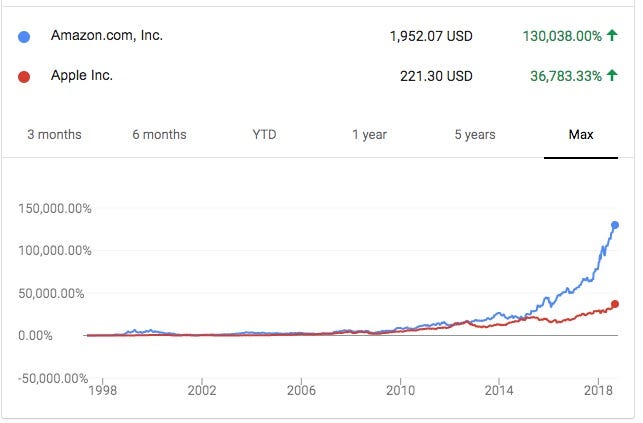Ownership is About Trust
An on-going series taking a look at the Amazon Leadership Principles from a startup point of view. Start here to see others.
The Amazon Leadership Principles are a set of 14 statements that drive the culture of innovation at Amazon. Each focuses on a different aspect of that culture and each holds interesting lessons for startups as they transverse their journeys from inception to success.
Ownership
Leaders are owners. They think long term and don’t sacrifice long-term value for short-term results. They act on behalf of the entire company, beyond just their own team. They never say “that’s not my job”.
Before exploring how ownership works at Amazon, it is important to understand the organizational structure. In Febraury, 2018, Amazon had 566,000 employees worldwide.

Geekwire Image
How does it effectively manage a workforce that is larger than many cities? When I worked at Amazon, and folks would ask how best to work with the organization, I first described Amazon as a huge VC with a portfolio of 1000s of small startups. Each group at Amazon operates interdependently, but separately. Each is a self-contained group that can make its own decisions, often dependently of other groups.
How does this work? With three key concepts: Leaders as Owners, Single Threaded Owner, and Two Pizza Teams.
Leaders as Owners
When you read the Leadership Principle, the first concept is Leaders are owners. There are several ways that this manifests itself at Amazon from compensation that over-indexes equity to the most important — trust.
At its core, Amazon is designed to trust its employees. It cannot work at the pace it does if there were multiple approval layers. Each individual has to have the ability to make decisions that are individually beneficial but drive the business itself, which in turns drives shareholder value.

Amazon vs Apple over the last 20 years
[Leaders] think long term and don’t sacrifice long-term value for short-term results. They act on behalf of the entire company, beyond just their own team.
This idea that everyone can impact the growth and success at Amazon is one of the key pillars of its culture.
Two Pizza Teams
At 566,000 people, it would lead to reason that teams would quickly get out of hand and be hard to lead if they were overly vertical. The solution? Decentralization. Yes, blockchain isn’t the first place that this has worked.
Famously, Bezos has said that “communication is terrible” and leads to less innovation and creativity, and that teams should be no larger than can be fed by two pizzas (approximately 8–10 people).
Why is communication terrible? The belief is that the reduction in using real data and subsequent conversations would add time and reduce risk-taking in decision making.
Does the Two Pizza Team actually exist at Amazon? Pretty much. Most individual teams (manager + team members) tend to be around ten people, and there are internal reorganizations as teams get larger. VP and Directors will manage around 10 managers maximum, with additional layers added to keep the teams relatively small. Even Bezos has only ten people (the S-Team) that report directly to him.
Single Threaded Owner
Look at any Amazon job description, and you will see the term “single-threaded owner.”

Google Search
What is a single threaded owner? At Amazon, the belief is that each employee is the Owner/key decision maker of a project, program, product or service.
There is one person who has overall responsibility for getting an idea off the ground or continuing the innovation of a current product.
Once a proposal gets an OK to proceed, a “single-threaded leader” is assigned to it, who may or may not be one of the people who took the lead on bringing the idea forward. “We empower the single-threaded leader,” Dave Limp says, “to go off and make great things.” Clearly, the term (coined and, as far as we know, used exclusively at Amazon) is a nod to programming, and means that the leader isn’t expected to multitask. In Wilke’s words, this is “someone who wakes up and just worries about that thing.” That’s “super important to how we invent,” Dave Limp insists, because “the best way to fail at inventing something is by making it somebody’s part-time job.” The leader is then able to hire a team, usually beginning with one or two technical people — just enough capacity to begin to get started and begin building the thing. — Forbes, “How Does Amazon Stay At Day 1?”
Your job, as a single-threaded owner, is to live and breath that one product. You may not have invented it, but you are entrusted to innovate its future. Does that mean the single threaded owner is also responsible for failure?
Yes and no.
Failure is often expected at Amazon. The best lesson I learned is that failure without learning is a loss. Learn something, and it’s a win. Focus on the win.
To invent you need to experiment. If you know in advance it is going to work it is not an experiment. They are inseparable twins, failure and innovation. You have to be willing to fail. It is embarrassing to fail. If I said to you, you have a 10 percent chance at a 100X return, you should take that bet every time. But you still are going to be wrong nine out of ten times. And you are going to feel bad nine out of ten times. — Jeff Bezos
Learnings for Startups
Trust your employees to make decisions that affect the entire company;
Give employees the latitude to invent by not over-burdening them with management responsibilities;
Use equity as a way to engender ownership rather than as an incentive.

This story is published in The Startup, Medium’s largest entrepreneurship publication followed by +367,690 people.
Subscribe to receive our top stories here.

